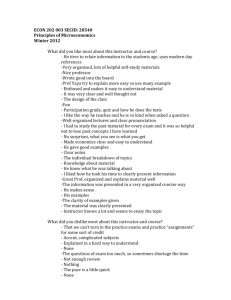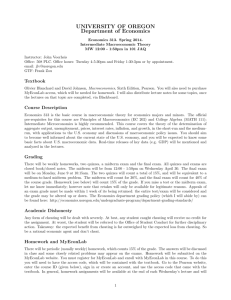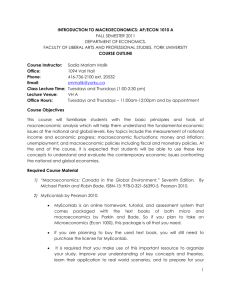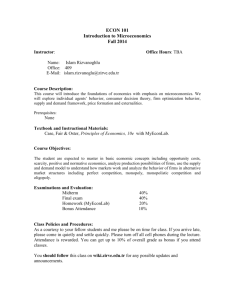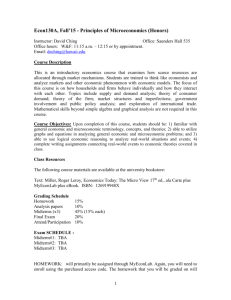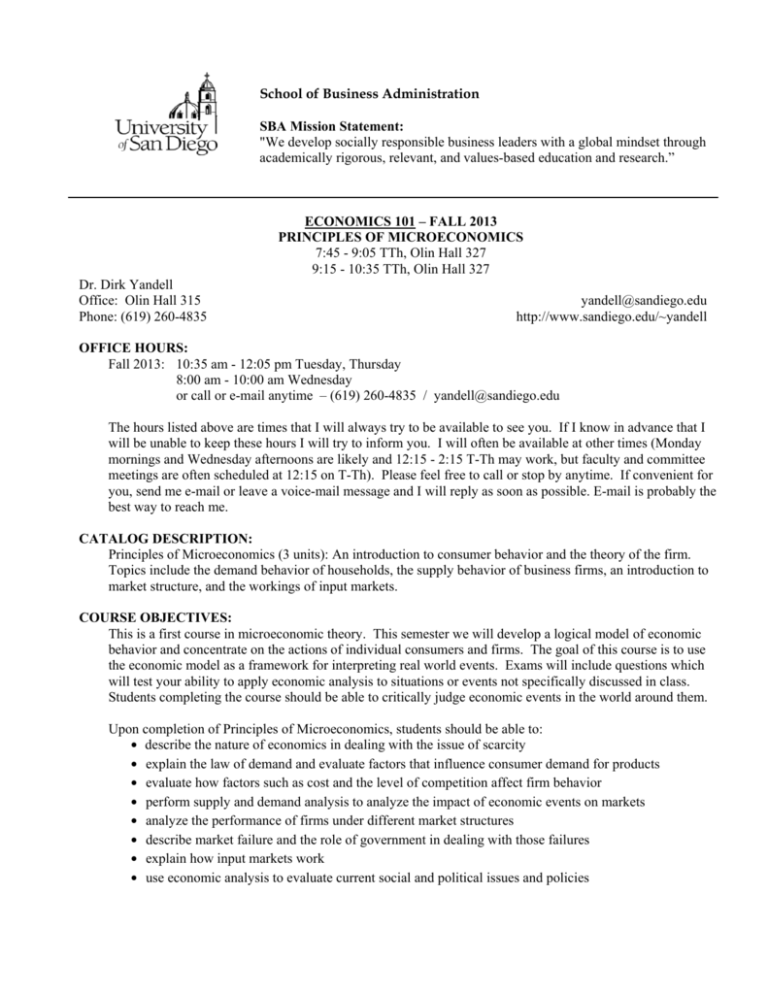
School of Business Administration
SBA Mission Statement:
"We develop socially responsible business leaders with a global mindset through
academically rigorous, relevant, and values-based education and research.”
ECONOMICS 101 – FALL 2013
PRINCIPLES OF MICROECONOMICS
7:45 - 9:05 TTh, Olin Hall 327
9:15 - 10:35 TTh, Olin Hall 327
Dr. Dirk Yandell
Office: Olin Hall 315
Phone: (619) 260-4835
yandell@sandiego.edu
http://www.sandiego.edu/~yandell
OFFICE HOURS:
Fall 2013: 10:35 am - 12:05 pm Tuesday, Thursday
8:00 am - 10:00 am Wednesday
or call or e-mail anytime – (619) 260-4835 / yandell@sandiego.edu
The hours listed above are times that I will always try to be available to see you. If I know in advance that I
will be unable to keep these hours I will try to inform you. I will often be available at other times (Monday
mornings and Wednesday afternoons are likely and 12:15 - 2:15 T-Th may work, but faculty and committee
meetings are often scheduled at 12:15 on T-Th). Please feel free to call or stop by anytime. If convenient for
you, send me e-mail or leave a voice-mail message and I will reply as soon as possible. E-mail is probably the
best way to reach me.
CATALOG DESCRIPTION:
Principles of Microeconomics (3 units): An introduction to consumer behavior and the theory of the firm.
Topics include the demand behavior of households, the supply behavior of business firms, an introduction to
market structure, and the workings of input markets.
COURSE OBJECTIVES:
This is a first course in microeconomic theory. This semester we will develop a logical model of economic
behavior and concentrate on the actions of individual consumers and firms. The goal of this course is to use
the economic model as a framework for interpreting real world events. Exams will include questions which
will test your ability to apply economic analysis to situations or events not specifically discussed in class.
Students completing the course should be able to critically judge economic events in the world around them.
Upon completion of Principles of Microeconomics, students should be able to:
$ describe the nature of economics in dealing with the issue of scarcity
$ explain the law of demand and evaluate factors that influence consumer demand for products
$ evaluate how factors such as cost and the level of competition affect firm behavior
$ perform supply and demand analysis to analyze the impact of economic events on markets
$ analyze the performance of firms under different market structures
$ describe market failure and the role of government in dealing with those failures
$ explain how input markets work
$ use economic analysis to evaluate current social and political issues and policies
COURSE MATERIAL:
A. Text: Economics, 4th Edition, 2013, by R. Glenn Hubbard and Anthony O’Brien,
Pearson Prentice Hall. This book is available online from the publisher or in the
USD bookstore. The textbook in the USD bookstore comes bundled with a
password for full electronic access to Prentice-Hall’s MyEconLab, a supplemental
resources website. (We will use MyEconLab for homework and possibly a quiz or
two during the semester, so electronic access is required.) MyEconLab access can
be purchased separately if you find an inexpensive textbook without an access
code. The USD bookstore version of the text includes MyEconLab access. The
book will also be used for Econ 102 in the Spring so you get two semesters for the
same price. (See the last two pages of this document for online ordering
instructions and details on how to register for MyEconLab.)
B. I will use “Personal Response Pads” (clickers) during class. USD has chosen the
“i>clicker” to be used across campus. The clicker can be purchased from the USD
bookstore or online. Registration details will be provided in class. The photo on the right
shows what it looks like. There are newer versions but the Gen 1 is cheaper and works
fine.
C. Limited free web resources (practice quizzes, review questions and practice problems) are available at
http://wps.prenhall.com/bp_hubbard_essentials_2/. This was designed for an earlier version of the
textbook but can still be helpful.
D. Wall St. Journal or daily newspaper strongly recommended.
E. Lecture material and class handouts.
COURSE REQUIREMENTS:
A. There will be 4 quizzes during the semester, each worth 40 points. You may drop your lowest score, and
there will be NO MAKEUPS. A missed quiz will be counted as the one you dropped. Total possible
points on quizzes: 120. The quizzes will be short (about 30 minutes), and they will be announced in
advance.
B. There will be a midterm exam given in class and announced in advance. The midterm exam will be worth
100 points.
C. A final exam will be given during finals week. The exam will be in our normal classroom, Olin Hall 327.
The final is worth 100 points. The final exam for this class is as follows : (Please arrange your holiday
travel schedule accordingly.)
Final exam for TTh 7:45 classes : Tuesday, December 17, 8:00 am - 10:00 am
Final exam for TTh 9:15 classes : Thursday, December 19, 8:00 am - 10:00 am
D. Exercises to be completed outside of class will be assigned regularly. About one assignment per chapter
will be done electronically on MyEconLab, and other homework will be assigned and collected in class.
Review questions will be done in class with the “i>clicker” personal response devices. A total of 100
points during the semester will be made up of homework assignments (in class and online), the clicker
points, and LLC related requirements. You will be allowed to drop your lowest homework assignment
score.
E. A short analysis paper will be worth 40 points. This out-of-class writing assignment will require that you
use tools developed in class to analyze a current economic issue of your choice. More details will be
provided later.
F. Quizzes and exams are to be done individually. Ethical behavior is expected, cheating is dealt with
severely. You may work in teams on the homework if you like, but each member must make contributions
and each person must turn in the complete assignment.
G. Grades will be based on student performance, with a total of 460 points available during the semester.
Generally, grades follow the distribution below:
semester average of
92% and above
90% - 91.9%
88% - 89.9%
82% - 87.9%
80% - 81.9%
78% - 79.9%
72% - 77.9%
70% - 71.9%
etc...
A
AB+
B
BC+
C
C-
CHANGE LIVING-LEARNING COMMUNITY and the PRECEPTORIAL PROGRAM
This preceptorial is part of the “Change” learning community. Living-learning communities (LLCs) are part
of a comprehensive first-year experience at USD. Each LLC theme has multiple linked preceptorial classes.
Preceptorials are first-year core curriculum courses with limited enrollment. I will be your professor for this
class but I will also serve as your academic advisor until you choose your major. I am available to help guide
you through course planning, registration, declaring your major, and other academic advising, usually for
your first year at USD.
Economics is a natural fit in the Change LLC. Microeconomics is the study of how individual decision
makers respond to scarcity and alternatives. How do changes in prices affect purchase decisions? How do
changes in cost or production technology change production decisions? What determines preferences and
how do they change over time? Many questions that we will address in class will involve the Change theme.
Economics is also a key tool to understand human behavior and to evaluate social, political, and cultural
issues. Links to other disciplines will be made throughout the class. Attendance at some LLC sponsored
events will be required for this class.
TEST, QUIZ AND ASSIGNMENT POLICY:
No makeup exams or quizzes will be given unless prior arrangements have been made. Exams and quizzes
will consist of multiple choice questions, problems, and short essay questions. Hand held calculators may be
used during examinations, but all are closed book exams. Finally, assume that if a graph or a formula would
aid your explanation, it belongs in your answer.
A one page handwritten or computer printed sheet (one or two sided) may be prepared for use on the quizzes
and exams. The sheet may contain any information that you wish (equations, explanations, prayers, etc...) as
long as you have created it.
No late assignments will be accepted. All out-of-class assignments are due at the beginning of the class on
the date they are due. The following requirements are to be followed for all assignments to be turned in:
Use only 8.5 x 11 inch paper
Do not use pages torn from spiral notebooks
Be neat; typing is expected for the analysis paper, other HW does not need to be typed.
Please staple all pages together (no folded corners, etc.)
I prefer that you do not use folders or other covers.
ACADEMIC INTEGRITY
Quizzes and exams are to be done individually. You may work in teams on the assignments if you like, but
each member must make contributions and each person must turn in the complete assignment. Ethical
behavior is expected, cheating is not tolerated. Acts of academic dishonesty are taken seriously and dealt with
harshly. Acts of academic dishonesty include: a) unauthorized assistance on an examination; b) falsification
or invention of data; c) unauthorized collaboration on an academic exercise; d) plagiarism; e)
misappropriation of research material; f) unauthorized access of an instructor’s files or computer account; or
g) any serious violation of academic integrity as established by the instructor. You are encouraged to review
the University's academic integrity procedures in the Undergraduate Bulletin:
http://www.sandiego.edu/honorcouncil/integrity.php .
ELECTRONIC DEVICES POLICY
Computers may be used in class if you use them to take notes or follow a class PowerPoint presentation. It is
not appropriate to use them for non-class related activities during class time. Phones (voice and text) and
other personal electronic devices should not be used in class, please keep them turned off. I may require that
all computers be put away for certain classes or during selected class activities.
USD ACADEMIC CALENDAR KEY DATES
Fall 2013
Wednesday, September 4 - Classes begin
Friday, September 13 - Last day to enroll in classes
Friday, October 25 - Fall Holiday (no classes)
Monday, October 28 - Mid-term deficiency reports due
Wednesday, November 6 - Deadline to select grade or Pass/Fail option (P/F option eligibility rules apply)
Wednesday, November 13 - Last day to withdraw from classes with a “W”
Wednesday, November 27 – Friday, Nov. 29 - Thanksgiving holiday (offices closed ThF; no classes WThF)
Friday, December 13 - Last day of regular classes
Saturday, Dec. 14 – Sunday, Dec. 15 - Study days
Monday, Dec. 16 – Friday, Dec. 20 - Final examinations (see official final exam schedule by class time)
See the complete 2013-14 academic calendar at
http://www.sandiego.edu/academics/academic_calendars/undergra_calendar_2013_2014.php
See the final exam schedule for Fall 2013 here:
http://www.sandiego.edu/documents/registrar/Fall2013FinalExamSchedule.pdf
The USD School of Business Administration Learning Environment
A key educational mission of the School of Business Administration is to develop socially responsible leaders. USD
students are future leaders in business and professional organizations, and setting an appropriate professional tone is an
important aspect of the learning environment.
The highest levels of learning can be achieved only if all members of the USD community understand and respect their
mutual professional obligations. Each of us participates in the quality of the learning experience through our daily actions
and choices. These choices are not simply personal or isolated, but often influence the quality of the learning experience of
others. Outlined below is a set of specific expectations - for both students and faculty - that support a professional learning
environment.
EXPECTATIONS FOR STUDENTS
EXPECTATIONS FOR FACULTY
Students will treat their classroom obligations as they
would treat any serious professional engagement.
Faculty will treat their obligations for classes as they
would treat any serious professional engagement.
1) PREPARING THOROUGHLY for each session in
accordance with the instructor's requests;
1) PREPARING THOROUGHLY for each class;
2) ARRIVING PROMPTLY AND REMAINING until
the end of each class meeting, except in unusual
circumstances; informing the instructor of any absences;
2) PUNCTUALITY in beginning class sessions on time,
and except under exceptional circumstances adherence
to the established schedule for all classes and exams;
3) PARTICIPATING FULLY AND
CONSTRUCTIVELY in all classroom activities and
discussions;
3) PROVIDING SUFFICIENT INFORMATION and
materials to enable students to prepare adequately for
class;
4) DISPLAYING APPROPRIATE COURTESY to all
involved in the class sessions in the USD community;
4) DISPLAYING APPROPRIATE COURTESY to all
involved in the class sessions. Courteous behavior
specifically entails communicating in a manner that
respects, and is sensitive to, the many individual
differences in the USD community;
5) USING TECHNOLOGY IN THE CLASSROOM
ONLY WHEN APPROPRIATE. Computers, mobile
phones (voice and text), and other personal electronic
devices should not be used in class, unless specifically
authorized by the instructor.
5) MONITORING APPROPRIATE TECHNOLOGY
USE IN THE CLASSROOM and clearly specifying
what uses are appropriate or allowed;
6) ADHERING TO DEADLINES AND
TIMETABLES established by the instructor;
6) SUPPLYING TIMELY INFORMATION ABOUT
STUDENT PERFORMANCE on projects, assignments,
and examinations;
7) PROVIDING CONSTRUCTIVE FEEDBACK TO
FACULTY MEMBERS regarding their performance.
Students should be as objective in their comments about
instructors as they expect instructors to be in their
evaluations of students.
7) PROVIDING CONSTRUCTIVE FEEDBACK TO
STUDENTS concerning their performance. Faculty
should be as objective in their feedback to students as
they expect students to be in their evaluation of faculty.
Portions adapted from the University of Chicago
5
ECON 101 - CHAPTER COVERAGE:
CHAPTER
TOPIC(S)
Ch. 1
Economics: Foundations and Models
Ch. 2
Trade-offs, Comparative Advantage, and the Market System
Ch. 3
Where Prices Come From: The Interaction of Demand and Supply
Ch. 4
Economic Efficiency, Government Price Setting, and Taxes
Ch. 6
Elasticity: The Responsiveness of Demand and Supply
Ch. 8
Firms, the Stock Market, and Corporate Governance
Ch. 9
Comparative Advantage and the Gains from International Trade
MIDTERM EXAM about here
Ch. 10 Consumer Choice and Behavioral Economics
Ch. 11 Technology, Production, and Costs
Ch. 12 Firms in Perfectly Competitive Markets
Ch. 13 Monopolistic Competition: The Competitive Model in a More Realistic Setting
Ch. 14 Oligopoly: Firms in Less Competitive Markets
Ch. 15 Monopoly and Antitrust Policy
Ch. 5
Externalities, Environmental Policy, and Public Goods
Ch. 7
The Economics of Health Care / The Economics of Information
Ch. 16 Pricing Strategy
Ch. 17 The Markets for Labor and Other Factors of Production (if time allows)
(Additional topics may be added if time permits)
FINAL EXAM
6
How to Register and Enroll in Your MyEconLab Course
Welcome to MyEconLab! To join your instructor's course, please complete the following two steps:
1. REGISTER for MyEconLab, and, 2. ENROLL in your instructor's course
To Register for MyEconLab
To register, you will need a student access code and a course ID.
If you don't have an access code, you can purchase access online at http://www.myeconlab.com.
You will have the choice to purchase access with or without a full etext. Once enrolled in your professor's
course, you will also have the option to purchase a discounted version of your text.
Textbook: Hubbard/O'Brien: Economics 4e
Course Name: Econ 101 - Microeconomics - Fall 2013 – 7:45 am or 9:15 am
Course ID:
yandell79444 (for the 7:45 am class)
yandell68395 (for the 9:15 am class)
Steps to Register:
1. Go to
http://www.myeconlab.com
2. In the “For Students” section,
click on the “Make sure you
have the Course ID to register
for your class” link.
3. Follow the instructions to
register. Full details are
provided.
4. Your Course ID is
yandell79444 (for the 7:45 am
class) or yandell68395 (for the
9:15 am class)
Here is a summary of the registration steps:
To register for your instructor’s online MyLab or Mastering course, follow these steps:
1.
From the MyLab / Mastering home page, click Student under Register.
2.
Enter the course ID your
instructor gave you, and click
Continue.
3.
Sign in or create an account:
o
First, check the
information on the right
side of the page to ensure
you are registering for
the correct course. If not,
click Enter a different
course ID.
7
o
Next, you will sign in or create an account.
You already have a Pearson account if you have used one of our online products before. (See a
list of programs). Enter your username and password and click Sign In.
If you think you have a Pearson account, but can’t remember your sign-in information, click
Forgot your username or password. An email will be sent, so we suggest checking your
account information before you begin your course registration.
If you don’t have an account, click Create. You will create a username and password and add
your contact information. Read and accept the license agreement; you can also choose to help
improve Pearson products and learn about new offers.
Click Create an Account. You now have a Pearson account! The username and password you
just created can be used for all your Pearson online products.
4.
Pay for access to your instructor’s online course.
o
If you already bought your access code, either bundled with your textbook or as an access code kit sold
individually, click Access Code. Enter your access code, one word in each box, and click Finish.
o
To use a credit card or PayPal, instead of an access code, click the button for the access you want.
Note: Some courses provide the option to purchase with or without the eText. The integrated eText is a
very powerful, flexible tool and, though you can buy the eText later, it costs less to buy the course
content + eText up front.
Next, enter billing and payment information, then review and submit your order.
Note: If using a parent’s credit card be sure to use the correct billing address and put your name in the
Your Name field—not the cardholder’s name.
o
If you’re waiting for financial aid, click Get temporary access without payment for 17 days, which is
near the bottom of the Payment Options page.
Click Yes when a message appears asking if you are sure you want temporary access. You will receive
an email with payment instructions.
Note: To stay in your course, use an access code, credit card, or PayPal before the temporary access
ends. If you don’t pay within 17 days, you will lose access to your instructor’s online course and may
miss deadlines or important notices from your instructor. Once you pay for full access, you are
reconnected to coursework already completed.
o
You will receive a confirmation page with your account and course information. Click Go to Your
Course to start your work.
Need Help? For assistance, please visit http://www.myeconlab.com/support.
8


